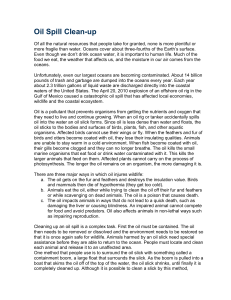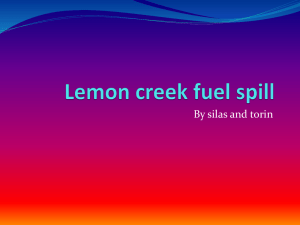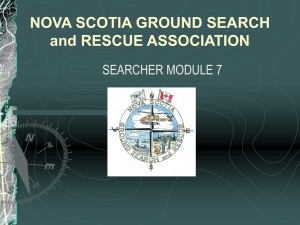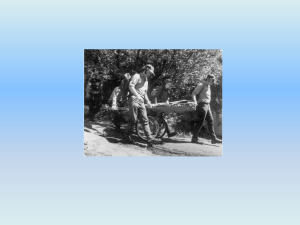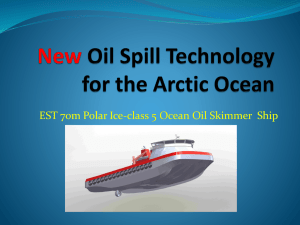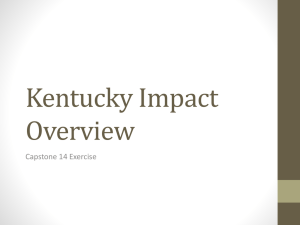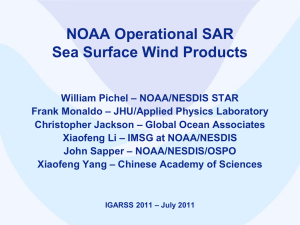1.1 Oil Slicks Detection with single
advertisement
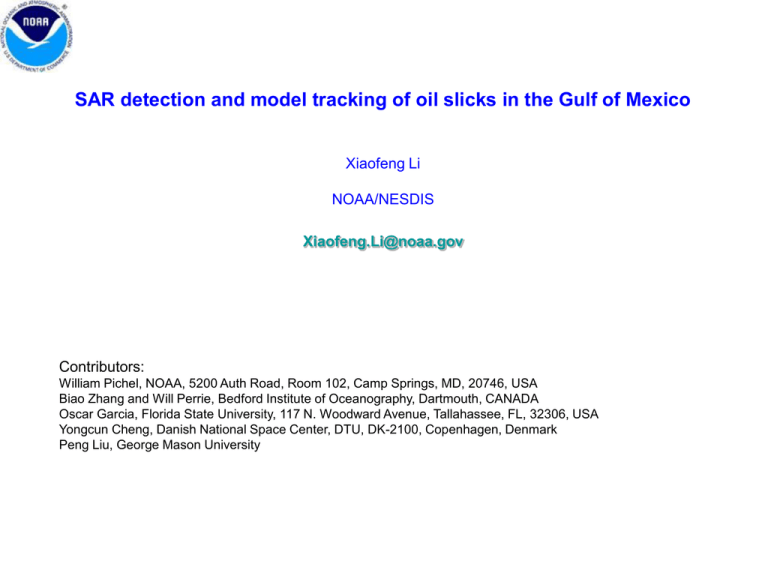
SAR detection and model tracking of oil slicks in the Gulf of Mexico Xiaofeng Li NOAA/NESDIS Xiaofeng.Li@noaa.gov Contributors: William Pichel, NOAA, 5200 Auth Road, Room 102, Camp Springs, MD, 20746, USA Biao Zhang and Will Perrie, Bedford Institute of Oceanography, Dartmouth, CANADA Oscar Garcia, Florida State University, 117 N. Woodward Avenue, Tallahassee, FL, 32306, USA Yongcun Cheng, Danish National Space Center, DTU, DK-2100, Copenhagen, Denmark Peng Liu, George Mason University Outline 1. Oil Spill Detection in SAR image 2. Tracking of oil spill movement in the Gulf of Mexico 3. Deepwater Horizon Event – NESDIS Effort to Map Surface Oil with Satellite SAR 1. Oil Slicks Detection with SAR Oil detection with image data and complex data: 1.1 Oil detection with single-pol SAR image 1.2. A Multi-Pol SAR processing chain to observe oil fields January, 2009 1.1 Oil Slicks Detection with single-polSAR image Mechanism: • Oil slick damp the ocean surface capillary waves – making the surface smoother • The smooth surface will reflect the radar pulse in the forward direction -> Less backscatter. Radar image is dark. Challenge: • There are a lot of look-alikes in the SAR image, i.e., low wind, coastal upwelling, island shadow, rain cell, biogenic slicks, etc. Solution: • Statistical method to extract oil slick from the SAR image • Separate the look-alikes from the oil slick 1.1 Oil Slicks Detection with single-polSAR image- Algorithms Neural Network Algorithm Canadian Journal of Remote Sensing, Vol 25, No. 5 2009 1.1 Oil Slicks Detection with single-polSAR image- Algorithms 8bit pixel value Wind Magnitud Wind Direction Wind Magnitud (-3 h) Wind Direction (-3 h) Wind Magnitud (-6 h) Wind Direction (-6 h) Wind Magnitud (-9 h) Wind Direction (-9 h) Beam Mode Incidence Angle Sea Surface Height Geostrophic Currents Magnitud Geostrophic Currents Direction Neighboor Texture 1 (Brightness) Neighboor Texture 2 (Contrast) Neighboor Texture 3 (Distribution) Neighboor Texture 4 (Entropy) Neighboor Texture 5 (variability) Neighboor Texture 6 (Std Deviation) 1st Filter Reaction 2nd Filter Reaction 3rd Filter Reaction 4th Filter Reaction 5th Filter Reaction 6th Filter Reaction 7th Filter Reaction 8th Filter Reaction 9th Filter Reaction Neural Network Algorithm demo Slick No-Slick 1.1 Oil Slicks Detection with single-polSAR image- Results 1.1 Oil Slicks Detection with single-polSAR image- Results 1.1 Oil Slicks Detection with single-polSAR image- Results in GIS In this example, Monitoring BP oil spill a SAR image was collected by Envisat on June 9, 20 Oil is detected close to Louisiana peninsula. TCNNA now has been trained to process SAR data from: -RADARSAT 1-2 -ENVISAT -ALOS TCNNA GUI: Display of a a pre-processed output. This Window of the GUI shows wind conditions prevailing on the data from CMOD5 model. A scaled image is rotated and shown to adjust contrast along incidence angles The TCNNA Output is exported with its Geo-referenced tagged information. Ready for Arcmap. TCNNA output handled and converted to Shapefile in ArcMap or Kml for Google Earth 1.1 Single-Pol SAR oil detection summary • • • Statistical-based SAR oil detection algorithms are developed These algorithm are tuned for RADARSTA-1, ENVISAT, ALOS, ERS in various beam mode Interactive oil spill analysis software have been developed to aid oil spill analysis at NOAA 1.2. A Multi-Polarimetric SAR Processing Chain to Observe Oil Fields in the Gulf of Mexico The combination of polarimetric features extraction • Total power span image span S hh 2 2 S hv S vh 2 S vv 2 * • Co-polar correlation coefficient • Target Decomposition entropy (H) mean scattering angle (α) anisotropy A • The combined feature F S hh S vv * S hh S hh * S vv S vv 3 H p i log 3 ( p i ) i 1 3 p i i i 1 1 2 A 1 2 F H A pi i 3 k 1 k PolSAR sea surface scattering • • • • Sea surface (Rough) Bragg scattering Low pol.entropy High HH VV correlation • • • • Oil spill (Smooth) Non Bragg scattering High pol. entropy Low HH VV correlation Example with: NASA UAVSAR polarimetric L-band SAR, with range resolution of 2 m and a range swath greater than 16 km, June 23, 2010 20:42 (UTC) A sub scene of UAVSAR image The image recorded by a video camera confirmed the oil spill. Extracted polarimetric features from the UAVSAR data The combined polarimetric features and the result of OTSU segmentation Case 2: RADARSAT-2 Oil slick observation Imaging mode: fine quad-pol SLC Azimuth pixel spacing: 4.95 m Range pixel spacing: 4.73 m Near range incidence: 41.9 degree Far range incidence: 43.3 degree Noise floor: ~ -36 dB VV HH R2 fine quad-pol SAR image of oil slicks in the GOM acquired at 12:01 UTC May 8, 2010 Case 2: RADARSAT-2 Oil slick observation Clean sea surface Under moderate radar incidence angles and wind speeds Surface Bragg scattering Oil slick-covered area Capillary and small gravity waves were damped Non-Bragg scattering Case 2: RADARSAT-2 Oil slick observation R2 quad-pol observations scattering matrix entropy alpha represent and characterize scattering mechanism Case 2: RADARSAT-2 Oil slick observation Entropy represents randomness of scattering mechanism Entropy low significant polarimetric information Surface Bragg scattering Entropy high backscatter becomes depolarized Non-Bragg scattering Case 2: RADARSAT-2 Oil slick observation Alpha angle characterizes scattering mechanism 30 ~ 30 o ~ 50 o o 50 Surface Bragg scattering dominates o 90 Dipole scattering dominates o Even-bounce scattering dominates Non-Bragg scattering Bragg scattering Case 2: RADARSAT-2 Oil slick observation CP for quad-polarization: For ocean surface Bragg scattering For non-Bragg scattering S HH and S VV have low correlation S HV is small S HH and S highly correlated VV phase difference is close to 180 phase difference is close to 0 o Re( S HH S * VV ) S HV 0 2 Re( S HH S VV ) S HV * 0 2 o Case 2: RADARSAT-2 Oil slick observation Case 2: RADARSAT-2 Oil slick observation 0 Zhang, B., W. Perrie, X. Li, and W. G. Pichel (2011), Mapping sea surface oil slicks using RADARSAT-2 quad-polarization SAR image, Geophys. Res. Lett., 38, L10602, doi:10.1029/2011GL047013. 1.2. A Multi-Polarimetric SAR Processing Chain to Observe Oil Fields in the Gulf of Mexico - Summary Experimental results demonstrate the physically-based and computer-time efficiency of the two proposed approaches for both oil slicks and man-made metallic targets detection purposes, taking full advantage of full-polarimetric and full-resolution L-band ALOS PALSAR SAR data. Moreover, the proposed approaches are operationally interesting since they can be blended in a simple and very effective processing chain which is able to both detect and distinguish oil slicks and manmade metallic targets in polarimetric SAR data. 2. Tracking of oil spill movement in the Gulf of Mexico • • • • Introduction to NOAA GNOME Oil drifting model GNOME Simulation Simulation results – case study Conclusions Main impacts are: - harm to life, property and commerce - environmental degradation 2. Tracking of oil spill movement in the Gulf of Mexico Oil Slicks drifting simulation with GNOME model GNOME (General NOAA Operational Modeling Environment) is the oil spill trajectory model used by NOAA’s Office of Response and Restoration (OR&R) Emergency Response Division (ERD) responders during an oil spill. ERD trajectory modelers use GNOME in Diagnostic Mode to set up custom scenarios quickly. NOAA OR&R employs GNOME as a nowcast/forecast model primarily in pollution transport analyses. GNOME can: •predict how wind, currents, and other processes might move and spread oil spilled on the water. •learn how predicted oil trajectories are affected by inexactness ("uncertainty") in current and wind observations and forecasts. •see how spilled oil is predicted to change chemically and physically ("weather") during the time that it remains on the water surface. GNOME input: - Location file, specific for each region (tide, bathymetry ,etc.) - User file Currents: Winds: Oil information: ocean model outputs model or buoy wind Oil locations from SAR image Model Output Spill Trajectory Types • Best Guess Trajectory (Black Splots) Spill trajectory that assumes all environmental data and forecasts are correct. This is where we think the oil will go. • Minimum Regret Trajectory (Red Splots) Summary of uncertainty in spill trajectories from possible errors in environmental data and forecasts. This is where else the oil could go. Case study: Oil pipeline leak in July 2009 Oil Pipeline leaking in July 2009 Oil pipeline leak in July 2009 Surface Currents: Navy Coastal Ocean Model (NCOM) outputs spatial resolution of NCOM is 1/8º temporal resolution is 3 hours Oil pipeline leak in July 2009 Winds: NDBC hourly wind vector Oil pipeline leak in July 2009 Initial Oil distribution information: denoted by blue dots. Model run: 7/26/2009 15:00 UTC 7/29/2009 04:00 UTC Simulation Results: GNOME simulated best guess trajectory of oil spill denoted by blue circles: 16:30 UTC on July 27, 2009 At the ending of the simulation, 04:00 UTC on July 29, 2009. Simulation Results: GNOME simulated best guess trajectory of oil spill denoted by blue circles: GNOME simulated locations of the oil spill at 04:00 UTC on July 29, 2009: (a) only use wind to force the model; (b) only use the currents to force the model. 2. Tracking of oil spill movement in the Gulf of Mexico - Summary • In this work, the GNOME model was used to simulate an oil spill accident in the Gulf of Mexico. The ocean current fields from NCOM and wind fields measured from NDBC buoy station were used to force the model. The oil spill observations from ENVISAT ASAR and ALOS SAR images were used to determine the initial oil spill information and verify the simulation results. The comparisons at different time show good agreements between model simulation and SAR observations. Marine Pollution Bulletin, 2010 Summary: • • • • SAR images from multiplatform spaceborne SAR satellite can be used for oil spill/seep detection in the Gulf of Mexico. Statistical-based oil spill detection algorithms have been developed for single-pol SAR image. These algorithms have been tuned for different satellites and different imaging mode. A Multi-Frequency Polarimetric SAR Processing Chain to Observe Oil Fields in the Gulf of Mexico are also developed to provide fast oil spill response at NOAA. The oil spill drifting can be simulated using the NOAA GNOME model with inputs from background current field, time series of wind measurement, and the initial oil spill location. Operational Response Requires: • • • • • • SAR is primary data, visible Sun glint secondary, others tertiary Need multiple looks per day received within 1-2 hours Many sources of data are required Well-trained staff of analysts (10-12) to cover multiple shifts per day Automated mapping would be useful for complicated spill patterns Array of model, in situ, and complementary imagery and products help by providing an oceanographic context. Wish for the Future: What if SAR data were available like this all the time at no per-image cost; i.e., just like most other satellite remote sensing data?
